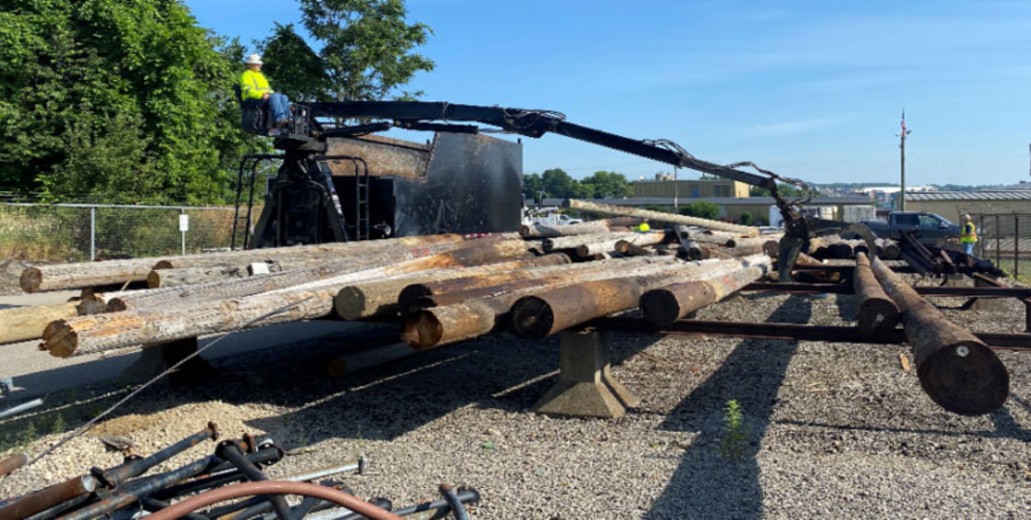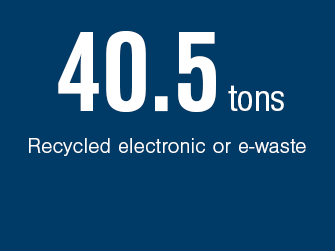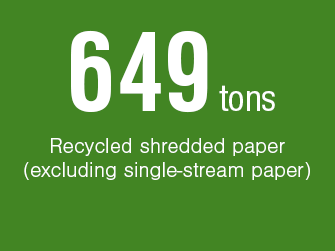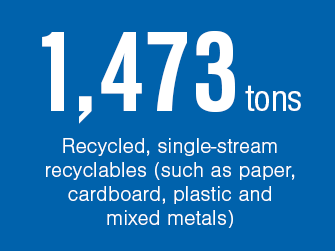WASTE MANAGEMENT AND REDUCTION
Providing our customers with reliable electricity requires that we responsibly and effectively manage the waste that results from our operations as we also find ways to minimize future waste and expand our recycling and reuse efforts. Waste streams at FirstEnergy include municipal waste, universal waste and hazardous waste. We work to reduce, reuse and recycle the waste we generate through several initiatives including the projects and programs described below.
As part of our commitment to compliance excellence, we track waste generated from our operations and submit periodic reports to regulatory agencies. Please see our data tables for waste and recycling metrics.
UTILITY POLE RECYCLING PROGRAM
Wood utility poles are one of FirstEnergy’s largest waste streams, contributing thousands of tons of waste each year.
Traditionally, a significant portion of wood utility poles from our transmission and distribution operations are landfilled when they are no longer viable for their intended purpose. Through our Wood Pole Diversion Program, all operating companies across FirstEnergy’s service territory now divert the poles from landfills into various reuse and recycling options available in each state. Since the beginning of the pilot phase, we have diverted nearly 4,900 tons of wood poles, which found new life in farmers’ fields and parks or were milled into lumber.

RECYCLING AND INVESTMENT RECOVERY PROGRAM
At our Miles Service Center in Cleveland, we manage the company’s surplus assets, primarily wire and cable, through reuse, refurbishment and sale. By repairing or processing materials and products for reuse, we reduce new material purchases while creating less landfill waste and mitigating our environmental impact. Additionally, the company generates revenue by processing scrap wire and cable. Each month, the Miles Service Center sorts and handles approximately 200,000 pounds of scrap material, which generated a net benefit of nearly $2.5 million in 2023 alone. This program is part of our ongoing efforts to develop increasingly sustainable operations.
Please see our data tables for our investment recovery and recycling metrics.
CONSUMER AND ELECTRONIC WASTE RECYCLING PROGRAMS
Across our companywide operations, FirstEnergy recycles company electronic waste, such as computers and phones.
Recycling Efforts in 2023



BENEFICIAL REUSE
As part of our focus on environmental compliance excellence and stewardship of natural resources, FirstEnergy is committed to the responsible disposal of coal combustion residuals (CCRs). CCRs – in the form of bottom ash, fly ash, synthetic gypsum and calcium sulfite – are the byproducts that remain after coal is burned to make electricity. These materials are transported to state-of-the-art dry disposal facilities that use liners and leachate collection systems, as well as extensive groundwater monitoring, to help ensure environmental protection. We maintain a CCR management program to meet all compliance requirements of the Federal Coal Combustion Residual regulations.
When possible, we also strive to beneficially use CCRs, which are common ingredients in concrete roads, drywall and a wide variety of other construction materials. By diverting CCRs from landfill to more beneficial uses, we reduce the need for waste disposal sites.
To review our CCR compliance reports for the facilities we manage, please visit our CCR website.
RESTORING AND REPURPOSING LAND FOR BENEFICIAL USE
Advancing FirstEnergy’s goal to own at least 50 MW of solar generation in West Virginia by 2025 is a key step toward executing our climate strategy and building a sustainable energy future. In January 2024, Mon Power completed work and placed the Fort Martin solar site in service. The site is the first of five planned solar sites Mon Power and its sister company Potomac Edison have planned to help bolster and diversify the region’s energy mix. The projects are located on brownfield sites or previously impacted properties. Specifically, the Rivesville Solar Site (5.5 MW) is located on a closed ash disposal site formerly used for the retired Rivesville Power Station; and the Marlowe Solar Site (5.8 MW) is located on a reclaimed ash disposal site formally utilized by the retired R. Paul Smith Station. Pending approval, the Davis Solar Site (11.5 MW) will be located on a reclaimed strip mine. FirstEnergy is proud to be repurposing previously impacted land or otherwise unusable land for renewable generation for our customers.
Public Notice
Disposal of PCB Remediation Wastes at Non-TSCA Approved Landfills
The attached approval ("Approval") from USEPA, dated February 13, 2020, allows FirstEnergy and its subsidiaries to dispose of PCB Remediation Waste with as-found concentrations of < 50 ppm in non-TSCA approved landfill facilities, including municipal solid waste landfills, as found in Condition 9 of the Approval.
